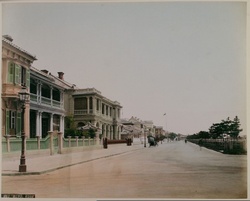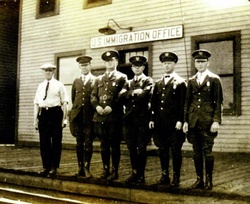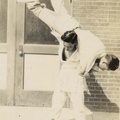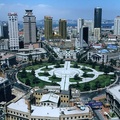Mr. Y, a native of Kagoshima Prefecture who came to California through the California Agricultural Worker Program, was working hard under the scorching sun with several dozen fellow Armenian colleagues at a vineyard run by an Armenian family in Indio, near the Arizona border in the southern part of the state. 1
One day, Mr. Y found out that there was an elderly Issei living alone on a nearby farm, so he decided to go and meet him. After talking to him, he discovered that he was from the same Kagoshima prefecture as Mr. Y. He told Mr. Y about his own harsh life as an immigrant.
Ever since he was old enough to understand, he had a vague desire to achieve something big and make a name for himself. At the beginning of the 20th century, many people from Kagoshima Prefecture had already emigrated to the United States. Some of these people achieved a certain degree of economic success, while others returned to Japan to marry women from their hometown.
Hoping to one day be like those who had returned from abroad, this Issei yearned to emigrate to America. Unfortunately, he never had the opportunity, so he took his chances and went to Kobe, where a ship departed for America. Once there, he met someone with the same goal of emigrated, and together they sneaked aboard a ship to cross the Pacific Ocean.
After many days of sailing, the ship crossed the Pacific Ocean. However, they arrived in Mexico, not America. They boarded a ship bound for Mexico. After leaving the ship, they headed north to America, walked for days, crossed the Colorado River on the border, and finally set foot on American soil.
A few days later, they finally arrived in a small town and began working on a farm there . They must have thought they had found a place of peace. However, soon after arriving in the town, they learned of the existence of the INS.
The INS was always on the lookout for illegal workers on farms around the country. They would often make surprise visits to farms to check the immigration status of those working there. Fearing that they would be found out to be illegally staying in the country and be deported, they had to leave the town and look for a new place to live. From this point on, the Issei walked a different path from the others who had come to America with them.
Whenever he heard a rumor that "INS officials might come to this town soon," he moved from town to town. He went everywhere, not only to California, but also to Arizona, Utah, Oregon, Washington, and so on.
Having been on the run repeatedly, he was unable to save enough money, was unable to make a triumphant return to his hometown of Kagoshima, and was unable to meet his life partner. Still, he believed in a bright future and lived each day desperately in the new land of America.
In the meantime, war broke out between the United States and Japan following the Japanese attack on Pearl Harbor. Many Japanese people were interned, but he was unaware of the current state of affairs and simply tried to survive in American society. And on that day, he had a fateful encounter with a young man from his hometown named Mr. Y.
After hearing the story of this orphaned elderly man, Ms. Y wanted to do something to help him, so she consulted with the Consulate General of Japan in Los Angeles.
A few months later, Shoichi Ban, who was a clerk at the Consulate General in San Francisco, sent him a letter and a California identification card. Ban had researched the laws regarding past immigration and confirmed that he was legally eligible to stay in the United States. He then applied for the card on his behalf, even though he could not read or write.
In fact, before the Japanese Exclusion Act was passed, Japanese who had entered the United States illegally were able to stay there legally by following certain procedures. In the prewar Japanese community, there were many different opinions on how to deal with those who had entered the United States illegally. In particular, there were people who exploited vulnerable people without passports or visas for their own personal gain, which became a major social problem, but at the same time, there were also compatriots who worked hard to rescue them. 4
If these Issei had had connections to the Japanese American community, if they had been able to read and write, and if they had been aware of the American legal system, I believe they would never have had to spend their lives fleeing from the clutches of the INS.
It is unclear what happened to him after he finally got his ID. He must have found a place of safety somewhere in California.
Hearing the story of this elderly Issei, I was suddenly reminded of Niijima Jo, the founder of Doshisha University. He was one of the Japanese who entered America through illegal means. In the early 20th century, there were Japanese who tried to emigrate to America even by smuggling. I believe that their existence should not be simply dismissed as people who committed illegal acts. I believe that their story reflects the special aspirations of people who sought happiness and prosperity in Japanese society at that time, when the old social system still remained. 5
For many Japanese today, illegal overseas travel brings to mind a very strong image of criminal acts committed by foreigners, such as illegal immigrants from neighboring countries.6 However , when we look into the history of Japanese society, we must not forget that there were Japanese who traveled abroad even at the great risk of entering the country illegally. I also believe that it is a fact in the history of Japanese society that among those who entered the country illegally, there were people who later had a major impact on Japanese society.
Notes:
1. According to Mr. Y, the work of the young people from Kagoshima at that time was highly praised by the local residents, and anti-Japanese sentiment in the town disappeared.
2. Abbreviation for “Immigration and Naturalization Service” – abolished in 2003 and transferred to the “United States Citizenship and Immigration Services.”
3. For more information about Ban, please refer to " Mr. Masakazu Ban and the Postwar Japanese Government's Immigration Policy ."
4. Sei Fujii, who is also featured in the movie "Lil Tokyo Reporter," was one of the people who worked hard to protect the human rights of the Issei who had illegally entered the country.
5. A few years ago, the National Museum of Japanese History in Sakura City, Chiba Prefecture, held a special exhibition on the history of the Japanese community. One of the exhibits included a model of a ship used by Japanese people living in Ehime Prefecture to sneak into the country.
6. According to the Japanese Ministry of Justice, there are currently about 60,000 illegal immigrants in Japan, about 70% of whom are from neighboring countries. Among them, there are many illegal immigrants from China and South Korea, which are now called "specific Asian countries," accounting for about 40% of the total.
© 2015 Go Takamichi







